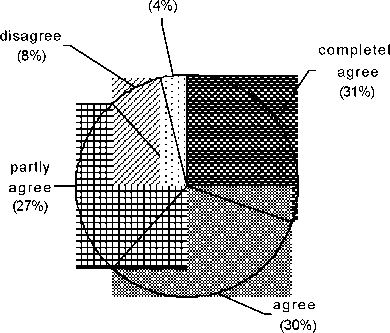The organizational structure was assessed using the same scheme. Most actors confirm that
their networks have a transparent and clear organizational structure and only a few explicitly
expressed themselves to be dissatisfied (Figure 5). The estimation of the condition of the
network organization by the network partner lay with a scale average of 3.8 on average on
the same level as the confidence climate; the range between the networks lay between 3.2 to
4.4. Every sixth network was at least 0.2 percentage points above or below the average
respectively and was correspondingly classified.
Figure 5
Participant rating of the internal
organization
"The organizational structures are
clear and transparent."
completel
disagree

Source: DIW Berlin and partners,
from summer
DIW Berlin 2002
Overall assessment
In order to assess the level of development in the networks, a simple indicator was
fashioned, namely the average ranking for the five indicators completeness, degree of
integration, level of confidence, quality of network management and transparency of internal
organization. When measured in this way, five networks’ development was considered to be
very good, while five displayed marked deficiencies.
At present this assessment can only be seen as an interim result. The indicators used are
still relatively rough and are partially based on incomplete information. All the same, a
comparison with the experience of accompanying research shows that this classification is
perfectly suitable to be used as a first point of reference.
12
More intriguing information
1. Are combination forecasts of S&P 500 volatility statistically superior?2. Robust Econometrics
3. The name is absent
4. Assessing Economic Complexity with Input-Output Based Measures
5. Contribution of Economics to Design of Sustainable Cattle Breeding Programs in Eastern Africa: A Choice Experiment Approach
6. Subduing High Inflation in Romania. How to Better Monetary and Exchange Rate Mechanisms?
7. Commuting in multinodal urban systems: An empirical comparison of three alternative models
8. Menarchial Age of Secondary School Girls in Urban and Rural Areas of Rivers State, Nigeria
9. The name is absent
10. Foreword: Special Issue on Invasive Species